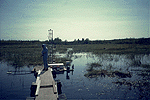TGB-1 BOREAS Operations 1994
Objectives:
To quantify and determine the controls on the exchange of trace gases, especially methane (CH4) and carbon dioxide (CO2), between boreal upland environments and beaver ponds with the atmosphere.
CH4 and Respiratory CO2 Fluxes
Types of Data and Equipment:
Fluxes were measured with a dark chamber technique in which a chamber was fit to the collars (or floated on the water surface) to begin the flux and aliquots of headspace air were removed at four to five minute intervals for 20 minutes with 60 ml polypropylene syringes. CH4 and CO2 concentrations in the syringes were measured at the Hayes Rd lab within 12 hours of collection using gas chromatography (flame ionization detection for CH4 and thermal conductivity detection for CO2). Fluxes were quantified by regressing the concentration changes against time; n=5 for CH4 and n=3 (ambient then first two syringe samples) for CO2. Temperature was measured in each chamber. Temperature was also measured at 0-2 cm, 10 cm and 20 cm at thermocouple arrays installed with each group of collars.
Summary of Places and Times of Measurements:
- NSA-OJP; Lichen, Moss and Aspen sites (12 collars)
- NSA-YJP; 4 collars over lichen/vaccinium groundcover
- NSA-OBS: moisture gradient from upland black spruce/feather moss to Sphagnum/Carex fen (28 collars)
- NSA-Beaver Pond Tower site: moisture gradient from dry feather moss ground cover to flooded pond edge (16 collars).
- NSA-beaver pond regional survey: with TGB-4; six ponds in the NSA (6-8 chambers in each)
- Duration/Frequency: each collar measured at 7-10 day intervals from early May to mid-September
CH4 and CO2 Soil Concentrations
Summary of Places and Times of Measurements:
- NSA-OJP; NSA-OBS
- Duration/Frequency: 7-10 day intervals from early May to mid-September
Types of Data and Equipment:
CH4 and CO2 depth profiles to ca. 90 cm were also taken weekly from tubes installed during August 1993 at OJP Moss and Lichen sites. Temperature (thermocouple) and TDR moisture profiles (w/ TGB-4) were continuously monitored at these sites during the same period. At the other sites, samples were taken by inserting a 1/8" stainless steel tube to depth and pulling gas. CH4 and CO2 concentrations in the syringes were measured at the Hayes Rd lab using gas chromatography.
Continuous CH4 Concentration and Flux by Gradient Methods
Summary of Places and Times of Measurements:
- NSA-OJP (w/ TF-8) and Beaver Pond towers (w/ TGB-4)
- Duration/Frequency: semi-continuous from early May to mid-September
Types of Data and Equipment:
Ambient air samples were analyzed from two heights on the NSA-OJP (30m and 16.5m) and the beaver pond tower (1.75m and 0.25 m). A continuous stream of air pumped from each height was automatically sampled and injected at approximately 6 minute intervals onto gc-fid s that were kept in continuous operations at the sites; one in the instrument shack, the other in a tent). A standard was run between each ambient injection. Precision (as coefficient of variation of a half hour running average of the standard) was about 0.18%. Five discrete determinations of the gradient were then combined into half hourly averages and the gradients were multiplied by transfer coefficients determined by heat, moisture and turbulent fluxes in order to calculate mass flux of CH4.
TGB Overview || TGB-1 | TGB-3 | TGB-4 | TGB-5 | TGB-6 | TGB-7 | TGB-8 | TGB-9 | TGB-10 | TGB-12
 Send a data request to the BOREAS Data Manager (BOREAS Investigators only)
Send a data request to the BOREAS Data Manager (BOREAS Investigators only)
E-Mail a comment on this page to the curator 
Send e-mail to Sara Golightley, the BORIS representative for the TGB group 
Return to the TGB Overview
Return to the BOREAS Science Groups Overview
Return to the BOREAS Home Page
Last Updated: November 5, 1997
 The BOREAS Information System
The BOREAS Information System
 The 3 meter flux tower at the NSA beaver pond
The 3 meter flux tower at the NSA beaver pond